There are many software that can be used for note taking. Below is a list of the best software for note taking:
If you want to be productive and keep your thoughts, ideas and to-do’s organized, a software for note taking is just what you need. In this comprehensive list, I’ve collected more than 15 best notes taking apps as well as listed several great features for each app.
Note taking is a necessary part of everyone’s life — be it students, bloggers, writers, or businessmen. Everyone needs to take down their points at meetings and conferences, and make notes while studying or reading. Under such circumstances, one needs the best possible digital tool for note taking.

The best software for note taking is OneNote. It’s an app that integrates with other programs in your computer, as well as online services like Google Docs and Dropbox, to allow you to keep all of your notes in one place.
It’s available on desktop computers, laptops, and mobile devices. If you have a Microsoft Office 365 subscription, you can even access it through the web browser on any device!
If you use OneNote on the desktop version of Windows 10 (or if you’re running Windows 7 or 8), there are some great features that make it ideal for note taking:
-You can organize your notes by different sections or subjects. This makes it easy to find any information that may be buried in the middle of your collection of notes. You can also color code different sections so that they’re easier to differentiate from each other (for example, yellow could be used for “work-related” notes while blue could be used for “personal” ones).
-The search function in OneNote is phenomenal—it will search every word within your document(s), which makes finding things much faster than having to scroll through pages manually looking for keywords that might not even appear anywhere near where they should be if you were searching through regular text files instead
Best software for note taking
Note-taking is a pretty personal thing. Some people are meticulous in their notebook organization, with careful folders, subheads, and bullets. Others, myself among them, take more of a scrawl-it-anywhere-you-can approach. However you like to take notes—whether they’re text-only or elaborate scrapbooks—there’s a notes app out there that can handle all your weird quirks and note-taking needs.
First, one big thing to mention. You can write notes anywhere: on the back of a napkin, envelope, important bill, or even in a notebook. It’s kind of similar with apps: you can stick notes into pretty much any old app, even if it’s not really designed for them. Example: Google Docs isn’t a great notes app, but I have notes about this article you’re reading now in the Google Doc I’m working from.
Turn ideas into action
So for this list, we didn’t look at every app that could be used to take notes—we were only interested in apps that were explicitly designed to be notes apps. We also only really considered general-purpose note-taking apps. There are some great super-niche notes apps designed for fiction writers or developers, but they aren’t fit for most people, so weren’t in consideration for a place on this list.
Even with these criteria in place, we still tested close to 40 different note apps. Here are the best note-taking apps we could find.
The best note-taking apps
- Microsoft OneNote for a free note-taking app
- Evernote for the ultimate digital notebook
- Apple Notes for Apple users
- Google Keep for Google power users
- Notion for collaboration
- Obsidian for power note-takers
See our favorite ways to use automation to improve how you put your notes to work, track action items from meetings, and put an end to regular copy-paste actions.
What makes a great note-taking app?
How we evaluate and test apps
All of our best apps roundups are written by humans who’ve spent much of their careers using, testing, and writing about software. We spend dozens of hours researching and testing apps, using each app as it’s intended to be used and evaluating it against the criteria we set for the category. We’re never paid for placement in our articles from any app or for links to any site—we value the trust readers put in us to offer authentic evaluations of the categories and apps we review. For more details on our process, read the full rundown of how we select apps to feature on the Zapier blog.
With so many apps to consider, we had some pretty strict criteria for what made a great notes app.
- First, the apps had to be good at what they claimed to do. This sounds like an easy bar to clear, but you’d be surprised at how many apps fell short. Not every note-taking app needs to have features like image-to-text conversion or stylus support, but if it boasted about them, they had to be well-executed and nice to use.
- Second, all the note-taking apps had to be quick and easy to use. The real competition here wasn’t other note-taking apps, but a pen and scrap of paper. If it wasn’t almost as convenient to open a notes app and create a quick note as it was to reach across my desk for a Moleskine and a pen, it didn’t make the cut. This rule also extended to other features: editing and sorting notes had to feel seamless and natural, rather than require a battle with a horrible user interface.
- Similarly, the biggest reason to have a notes app instead of a notebook is that you can access it from anywhere on any device at any time, whether you’re at your desk at work, chilling on your couch at home, or flying coast-to-coast. At a minimum, we required apps to be available on one desktop and one mobile platform, and to have some kind of offline functionality. You can’t be locked out of your notebook because you don’t have Wi-Fi.
- Finally, we had the value for money test. At Zapier, we love a good free app, but with things as permanent as notes, that has to be balanced against the likelihood of the service surviving the next few years and being able to offer server-based features like syncing. Many of the best apps charge a reasonable subscription price, and as long as it was warranted by the features offered, that was no barrier to inclusion.
Best free note-taking app
Microsoft OneNote (iOS, Android, macOS, Windows, Web)
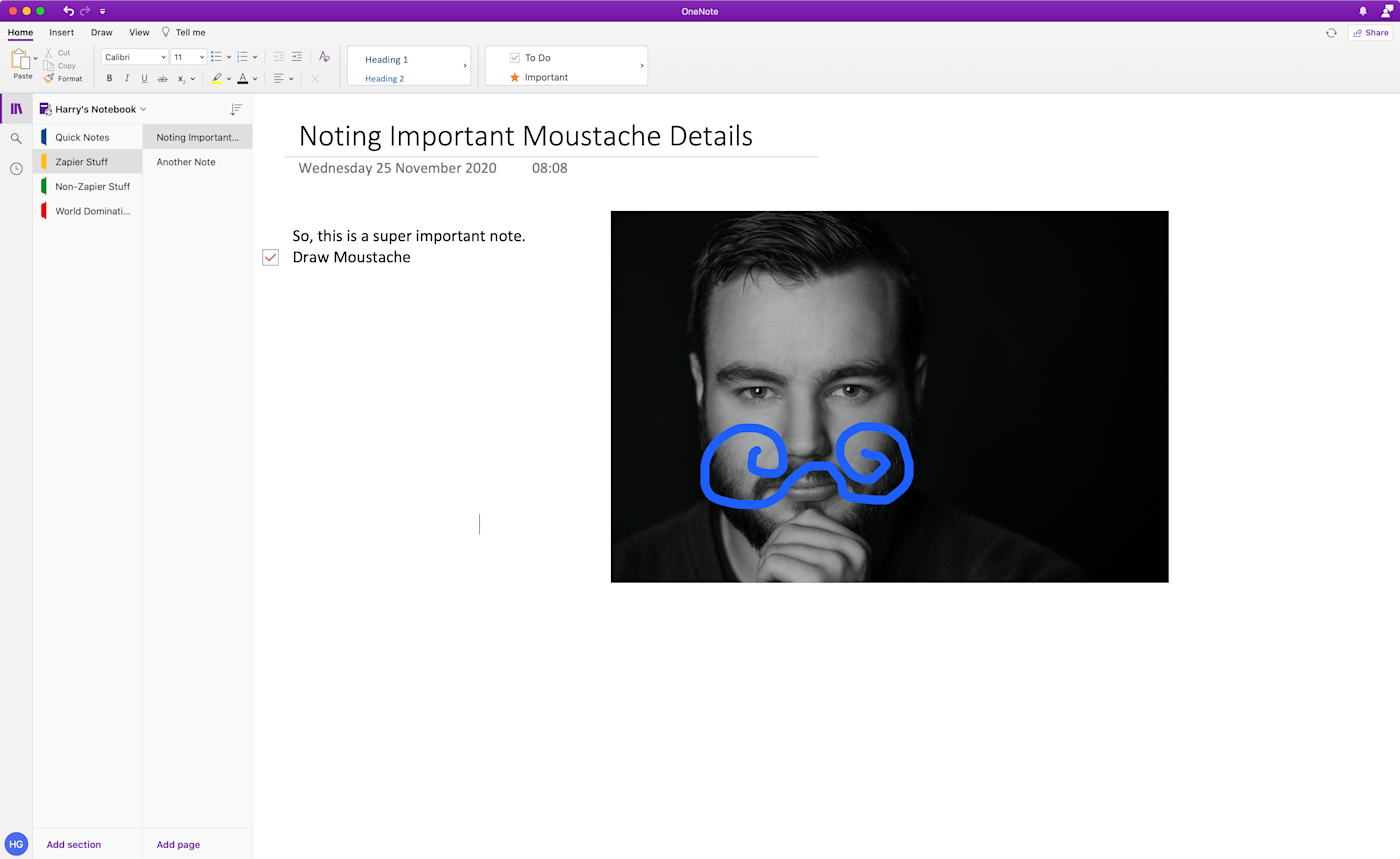
Microsoft OneNote is a free and full-featured note-taking app. It’s Microsoft’s answer to Evernote (the next app on this list), though without the need for a monthly subscription.
OneNote is incredibly freeform when it comes to taking notes. Each Notebook is modeled off a ringbinder, so it’s divided into sections with subsections called pages. And each page is basically a canvas where you can add any kind of note you like, anywhere you want. This means you can drag and drop in an image, click anywhere to add some text notes beside it, and if your computer supports a stylus, scribble a mustache on everyone in the photo. (Otherwise you can draw one on with your trackpad, but it’ll be less stylish.) It feels like a solution purpose-built for students and anyone else who has to take long, discursive notes about something, rather than people looking for a digital notebook to collect short snippets and random ideas.
I’d struggle to call any of Microsoft’s apps intuitive, but OneNote is familiar. The ribbon at the top of the app has five tabs: Home, which has all the basic formatting tools; Insert, which lets you attach files, images, audio recordings, and everything else; Draw, which gives you all the free drawing and highlighting tools; View, which lets you navigate the document and change how things look; and, finally, Tell Me, which is the help function. If you’ve used any version of Word, Excel, or PowerPoint in the last decade, you’ll be right at home.
In terms of pricing, although OneNote is free, it uses your OneDrive storage. You get 5GB included, which is more than enough for most people. But if you use OneDrive to store your photos, or save a lot of image and audio notes, you might hit against that limit. If you do, you can increase it to 100GB for $1.99/month.
With OneNote’s Zapier integration, you can automate OneNote to eliminate the hassle of moving information between apps. For example, Zapier can automatically create new notes in OneNote whenever you have a new task, note, or calendar event in another app.
Add notes on OneNote for upcoming Google Calendar events
Google Calendar, OneNote
Google Calendar + OneNoteMore details
Copy new Evernote notes to your OneNote notebook
Evernote, OneNote
Evernote + OneNoteMore details
Create OneNote notes from new or moved Trello cards
OneNote, Trello
OneNote + TrelloMore details
OneNote Price: Free for up to 5GB of notes; $1.99/month for 100GB.
Evernote and OneNote are the frontrunners in the note-taking category. Take a look at how they stack up in our Evernote vs. OneNote showdown.
Best note-taking app for the ultimate digital notebook
Evernote (Android, iOS, macOS, Windows, Web)
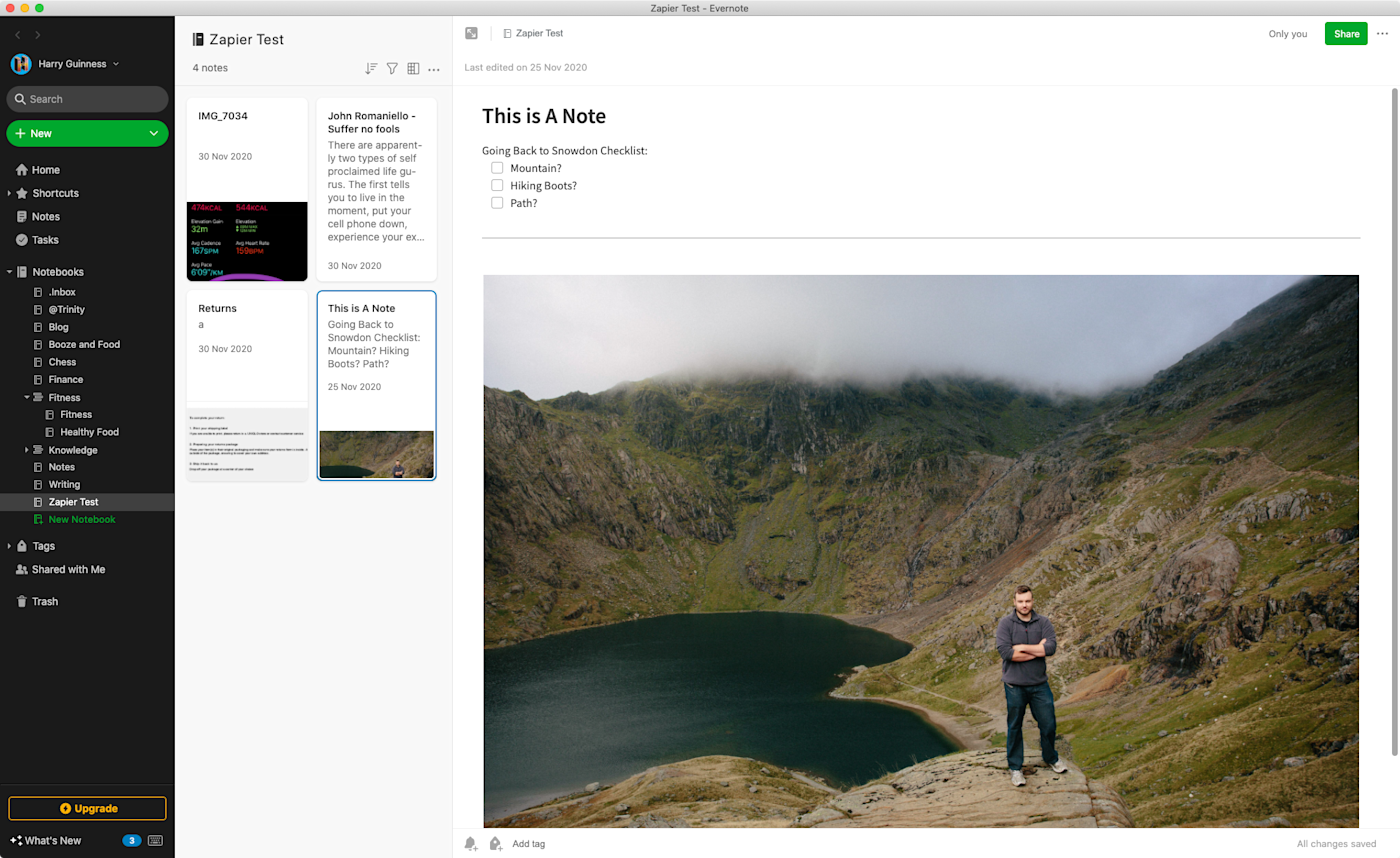
It’s impossible to talk about note-taking apps without mentioning Evernote, so it should be no surprise to see it on this list. It’s one of the most powerful options around and can handle notes in almost any format you want. You can add text notes, audio clips, images, PDF documents, scanned handwritten pages, Slack conversations, emails, websites, and anything else you can think of. If you’re the kind of person who’s as likely to scribble the outline to a best-seller on the back of a napkin as you are to save your shopping list as a voice memo, Evernote is great: it gives you one safe place to throw everything.
But Evernote isn’t just a dumping ground. It’s designed so you can easily sort and organize your notes. Create a new note by clicking New > Note, type whatever you want or add any of the supported note types, then, at the bottom of the screen, you can add tags. If you already have some tags set up, they’ll be auto-suggested; otherwise, you can type whatever you want and hit Enter. In the sidebar, click Tags to see a searchable list of every tag you’ve used. It’s a really fast way to sort notes as you create them, without having to worry about putting every note perfectly in its place.
Of course, later on, you can dive back in and arrange all your notes into meticulously sorted notebooks. In that case, click Notebooks in the sidebar and then New Notebook. Give it a name and you’ll be able to drag and drop notes from anywhere else in Evernote into it. Alternatively, you can right-click on a note, click Move, and then select your chosen notebook.
Evernote takes things a step further with its search functionality. If you upload an image of a sheet of paper, a business card, a menu, a sign, or anything else with text, Evernote automatically processes the image to make it more readable—and then processes the text to make it searchable. So, if you add a photo of your favorite pancake recipe, you’ll be able to search for it as if it’s a text note you typed yourself. Evernote even works with handwritten notes, though with the huge caveat that your writing must be neat enough that a computer can read it. (Mine, sadly, is not.)
It’s similar with PDFs and other documents you upload—if you have a Premium Evernote subscription, the text is searchable throughout the app.
Crucially, that $7.99/month Premium Evernote subscription needs to be mentioned. Evernote’s free plan doesn’t make this list. It’s limited to two devices, and you can’t save notes for offline access on mobile. Microsoft OneNote is a significantly better free option, if you never intend to upgrade to a paid plan. However, if you’re looking for the ultimate everything notebook and don’t mind the monthly fee, then Evernote is the app for you.
Evernote integrates with Zapier, letting you automate your note-taking. For example, you can automatically create tasks from Evernote reminders, or create new notes for calendar events.
Add notes to Evernote for new Google Calendar events
Evernote, Google Calendar
Evernote + Google CalendarMore details
Add Evernote reminders to Any.do as tasks
Any.do, Evernote
Any.do + EvernoteMore details
Evernote Price: Very limited free plan; $7.99/month for Evernote Premium with unlimited devices and offline mobile access.
If you decide on Evernote, check out 30 tips for Evernote to make the most of your notes. And take a look at 5 hidden Evernote features.
Best note-taking app for Apple users
Apple Notes (iOS, macOS, Web)
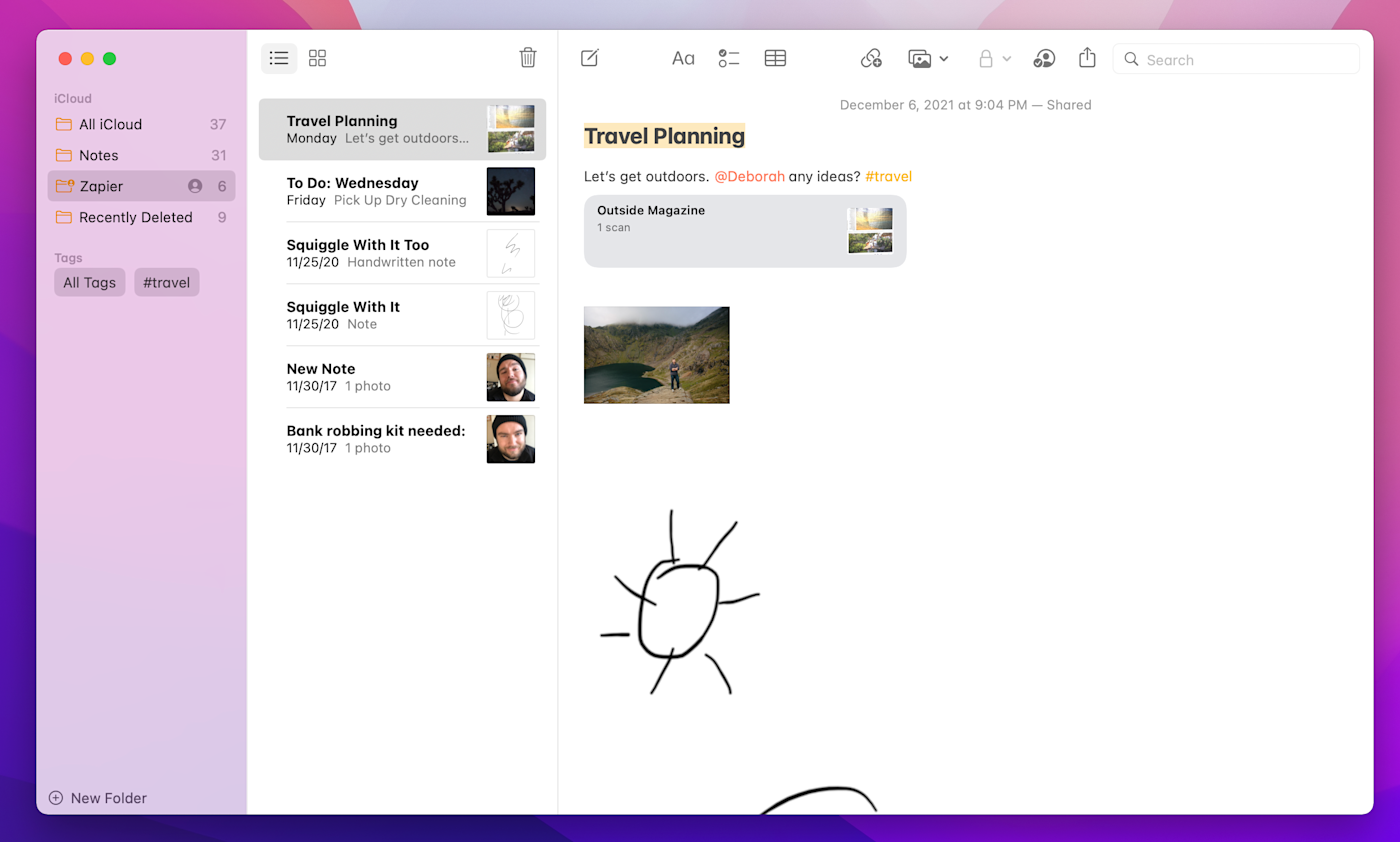
If you’re firmly entrenched in Apple’s ecosystem, you don’t have to look too far for a great, free note-taking app. Apple Notes (variously called Notes or iCloud Notes, depending on how you’re accessing it) is built into macOS and iOS, and can also be used through your browser. Just head to icloud.com/notes, and you get an online version of the app with all your synced notes—even if you’re on a PC or Chromebook. It’s a nice bonus that keeps your notes from being totally locked into your Apple devices, provided you have enough iCloud space to store everything.
Apple Notes is a little more barebones than our previous two picks, but that’s not really a dealbreaker. It’s convenient, easy to use, and even integrates with Siri. And it keeps getting better. Apple recently added tags—type #whatever to add one to any note—and you can share notes with other Apple users, and now even @mention them. Search is also pretty powerful. You can look for images, text you’ve written, a particular attachment, drawings, text scanned in a document, or something inside the image you’re trying to find (for example, “a bike”).
Once you create a new note, you can add text, attach images, scan documents, draw or handwrite, add checklists, format things into tables, and more. You can add multiple different things to a single note—but unlike with OneNote, they’re compartmentalized. You can’t, for example, use the pen tool to scratch out a text note.
Of course, as a first-party Apple app, Notes plays nice with the whole Apple ecosystem. One clever feature is that you can use your iPhone or iPad to add content directly to Notes on your Mac. Open a new note, click the Attach dropdown, and then choose from Take Photo, Scan Document, and Add Sketch. If you click Scan Document, for example, the camera will open on your iOS device and you’ll be able to automatically scan, process, and add letters, recipes, bank statements, and any other documents as PDFs.
While not as basic as it once was, Apple Notes is still very functional and checks all our requirements for a great note-taking app. Power-user features can be useful, but most users aren’t power users—and Apple knows it.
Apple Notes Price: Free for 5GB of storage across all iCloud services; starts at $0.99/month for 50GB.
There’s a very healthy notes app ecosystem for Apple devices; however, since they’re all paid products and Apple Notes is so good, none of them made this list. For more options, check out our picks for the best Mac note-taking apps.
Best note-taking app for Google power users
Google Keep (Android, iOS, Web, Chrome)
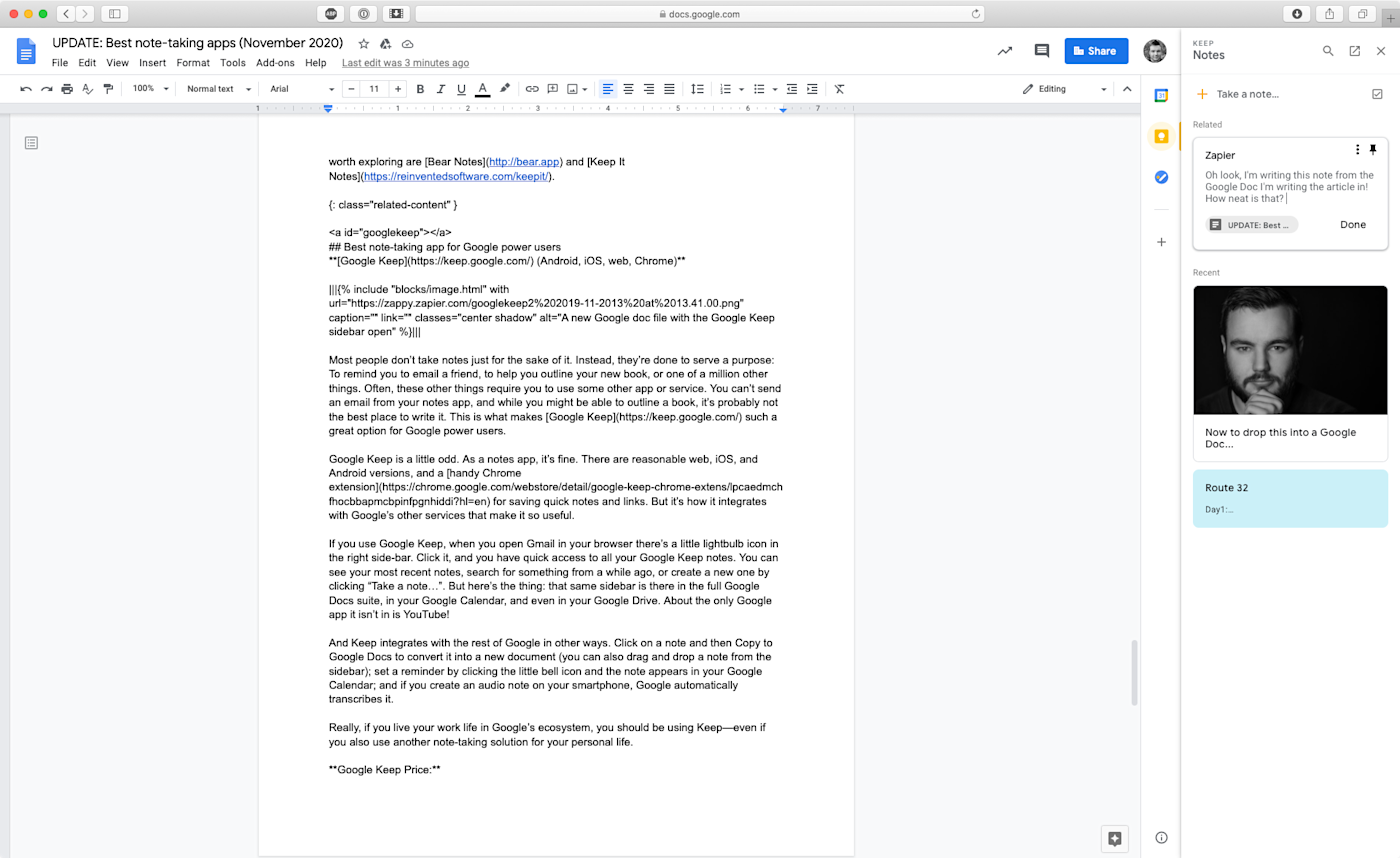
Most people don’t take notes just for the sake of it. Instead, they’re done to serve a purpose: to remind you to email a friend, to help you outline your new book, or one of a million other things. Often, these other things require you to use some other app or service. You can’t send an email from your notes app, and while you might be able to outline a book, it’s probably not the best place to write it. This is what makes Google Keep such a great option for Google power users.
Google Keep is a little odd. As a notes app, it’s fine. There are reasonable web, iOS, and Android versions, and a handy Chrome extension for saving quick notes and links. But it’s how it integrates with Google’s other services that makes it so useful.
If you use Google Keep, when you open Gmail in your browser, there’s a little lightbulb icon in the right sidebar. Click it, and you have quick access to all your Google Keep notes. You can see any notes related to the thing you’re working on, your most recent notes, search for something from a while ago, or create a new one. But here’s the thing: that same sidebar is there in all of your Google Docs, in your Google Calendar, and even in your Google Drive. About the only Google app it isn’t in is YouTube.
And Keep integrates with the rest of Google in other ways. Click on a note and then Copy to Google Docs to convert it into a new document (you can also drag and drop a note from the sidebar if you have Google Docs open); set a reminder by clicking the little bell icon, and the note appears in your Google Calendar; and if you create an audio note on your smartphone, Google automatically transcribes it.
Really, if you live your work life in Google’s ecosystem, you should be using Keep—even if you also use another note-taking solution for your personal life.
Google Keep Price: Free for 15GB of storage across all of Google apps; starts at $1.99/month for 100GB.
Best note-taking app for collaboration
Notion (Android, iOS, macOS, Windows, Web)

Note-taking can be something you do for yourself, or something you do with and for others. All the apps we’ve looked at so far are mostly for taking notes for yourself. Sure, you can share and collaborate on notes and even notebooks, but their main features lie elsewhere. With Notion, collaboration on all aspects is built in from the start.
Notion is the only app on this list that skirts the provision of it being a note-taking app. It is, but because of its collaborative features, it can be so much more. It’s basically three tools in one: a powerful notes app (which is why it’s on this list), a task and project manager, and a reference wiki. How you combine those three things is up to you.
Each new document or note is called a page, and everything in Notion is referred to as a block. Blocks include basic elements like text, checklists, and headings, as well as media types like images, web bookmarks, video, audio, code snippets, and files. You can use as many blocks you want, in whatever combination, on every page. They’re super quick to insert: just type / and scroll through the list. There are lots of templates built in too, so don’t feel you have to customize absolutely everything when you’re starting out. Just click on Templates in the sidebar and look through the options to find one you like.
The sidebar is also how you browse all your pages. It’s split into two sections: Workspace, which is all the pages you share with the rest of your team, and Private, where you can have your own notes. While collaboration is a big part of Notion, it’s not forced on you. Everyone has their own section where they can work on things—and then move them out to the public areas for feedback and revision. It’s a great way for an entire team to work together without getting in each other’s way.
One thing to note: Notion bills itself as an Evernote competitor for personal users. It can be—but it’s too much for most people, and its offline functionality isn’t the best. If you love the idea of Notion, go right ahead and try the free Personal Plan, but to us, it’s really best as a team notes app.
Notion integrates with Zapier, so you can connect it to thousands of other apps to do things like automatically generate Google Calendar events or save Slack messages to a table in one of your notes.
Save new Slack channel messages to databases in Notion
Notion, Slack
Notion + SlackMore details
Notion Price: Free for personal users; free trial for team users with a 1,000 block limit; from $10/month/user for teams with unlimited blocks.
Best note-taking app for power note-takers
Obsidian (Android, iOS, macOS, Windows, Linux)
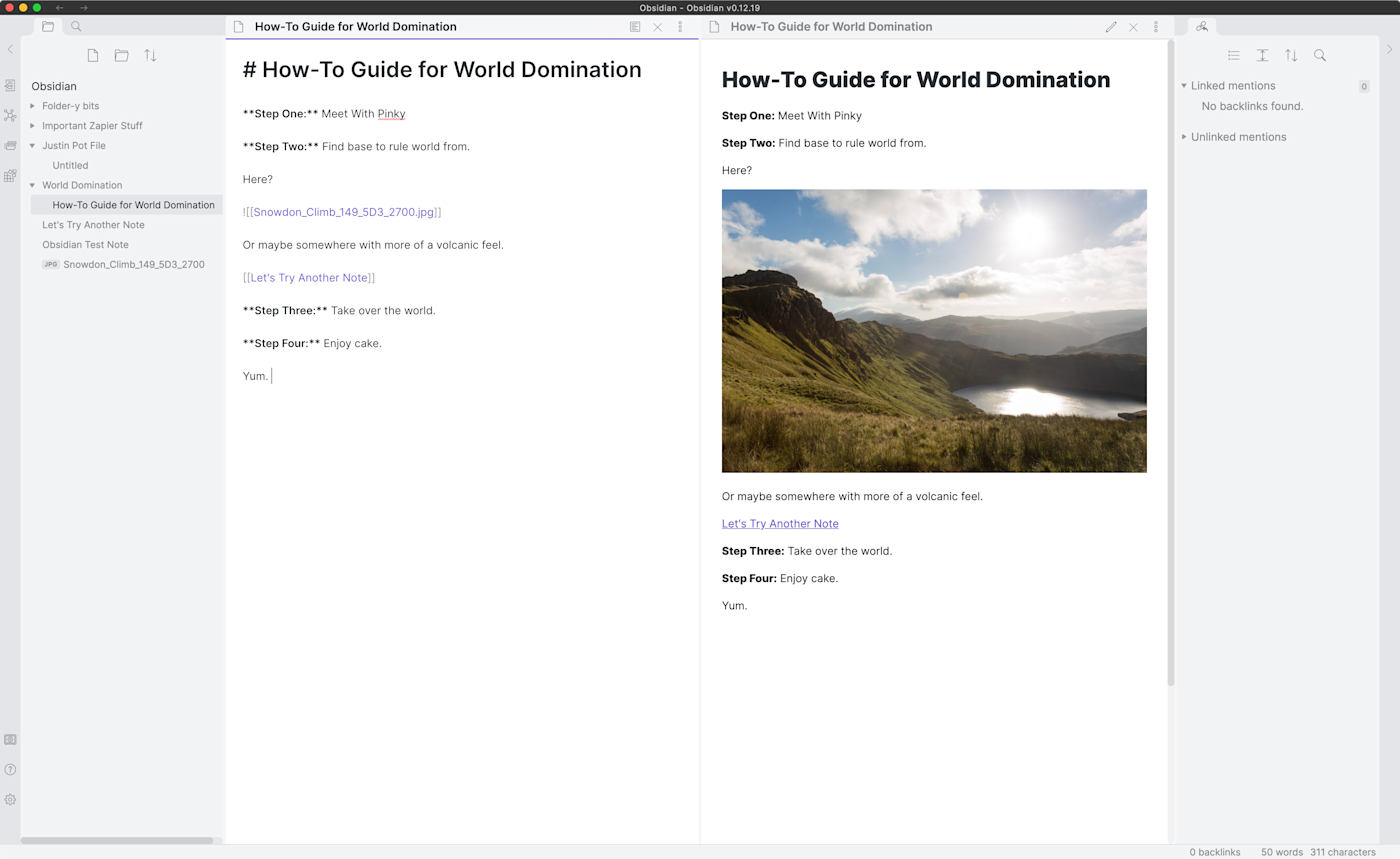
Obsidian is one of a new category of note-taking apps that push the boundaries of what a note-taking app can—and should—do. Along with Notion and Roam Research (which didn’t make this list because of its lack of offline support), it strives to be an all-encompassing digital database for your life—and kind of pulls it off.
Obsidian has a much steeper learning curve than the other apps on this list, so only check it out if you’re prepared to put in the work to get it set up to your needs. At its core, it’s just a notes app that uses text files formatted in Markdown, but things can get more complicated quickly.
You can sort your notes into folders and subfolders using the sidebar, but more interestingly, you can link between them using internal hyperlinks. Typing [[ brings up a dialog box that lets you select any other note to link to. This means you can easily reference notes you’ve previously created; for example, you can create a list of all the books you’ve read in the last year and link to the notes where you review them.
On top of that, you can basically customize anything you want. You have total control over the interface and can have as many notes as you want open in the same window. There are even community plugins, which add features—like a kanban board—that take it far beyond simple text files. My colleague Justin Pot told me, “Obsidian has literally changed my life,” and I don’t think recommendations come much stronger than that.
Obsidian Price: Free for most features; optionally, from $25 for exclusive features. Premium add-ons offer services like Sync from $8/month.